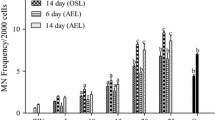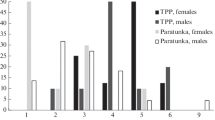Abstract
Amphibians are one of the most poorly studied groups of vertebrates in ecotoxicology and radioecology. The level of cytogenetic damage in the blood cells of tadpoles Rana arvalis Nilsson living on the territory of the Ukhta district of the village of Vodnyi in the Komi Republic, which is contaminated with technogenic radionuclides and heavy metals, is evaluated by “Comet assay”. It is shown that, in animals that develop in water bodies with high concentrations of radionuclides and heavy metals, the frequency of alkalilabile sites and single-strand break of DNA is higher than in the control area. No significant differences have been found when estimating the level of double-strand break of DNA. AFLP analysis indicates a weak genetic differentiation of the studied populations of amphibians.
Similar content being viewed by others
References
Anufriev, V.M. and Bobretsov, A.V., Amphibians and Reptiles, St. Petersburg: Nauka, 1996.
Vodyanitskii, Yu.N., Equations for assessing the total contamination of soils with heavy metals and metalloids, Eurasian Soi Sci., 2010, no. 10, pp. 1184–1188.
Grin, I.R., Konorovsky, P.G., Nevinsky, G.A., and Zharkov, D.O., Heavy metal ions affect the activity of DNA glycosylases of the FPG family, Biochemistry (Moscow), 2009, vol. 74, no. 11, pp. 1253–1259.
Evseeva, T.I. and Geras’kin, S.A., Combined Effect of Radiation and Nonradiation Factors on Tradescantia, Yekaterinburg: Ural Division RAS, 2001.
Evseeva, T.I., Geras’kin, S.A., and Vakhrusheva, O.M., Evaluation of the partial contribution of naturally occurring radionuclides and nonradioactive chemically toxic elements in formation of biological effects within the Vicia cracca population inhabiting the area contaminated with uranium-radium production wastes in the Komi Republic, Radiats. Biol. Radioekol., 2014, vol. 54, no. 1, pp. 85–96.
Kryukov, V.I., Influence of chemical pollution of agroecosystems on the frequency of chromosome aberrations in anurans, Russ. J. Ecol., 1999, vol. 30, no. 5, pp. 357–360.
Directive Document RD 52.24.643-2002: The Method of Complex Assessment of Surface Water Contamination Degree by Hydrochemical Indicators”, Moscow: Media Servis, 2012.
Moskvitina, N.S., Kuranova, V.N., and Savel’ev, S.V Disturbance of the embryonic development of vertebrates under conditions of technogenic pollution, Sib. Ekol. Zh., 2011, no. 4, pp. 487–495.
Pyastolova, O.A., Vershinin, V.L., Trubetskaya, E.A., and Gatiyatullina, E.Z., Utilization of amphibians in bioindication research on territories of the Eastern Urals radioactive trace, Russ. J. Ecol., 1996, vol. 27, no. 5, pp. 361–365.
Severtsova, E.A. and Aguillon Gutierrez, D.R., Postembryonic development of anurans in ponds littered with metal-containing refuse (simulation experiments), Biol. Bull., 2013, vol. 40, no. 9, pp. 738–747.
Taskaev, A.I. and Kichigin, A.I., Aquatic Harvest Industry: Radium Production in the Komi Republic, Syktyvkar: Komi Science Centre, Ural Division RAS, 2002.
Angeletti, D., Carere, C., and Editors, G., Comparative ecogenotoxicology: monitoring the DNA of wildlife, Curr. Zool., 2014, vol. 60, no. 2, pp. 252–254.
Bal, W., Protas, A.M., and Kasprzak, K.S., Genotoxicity of metal ions: chemical insights, Met. Ions Life Sci., 2011, vol. 8, pp. 319–373.
Beresford, N.A., Barnett, C.L., Howard, B.J., et al., Derivation of transfer parameters for use within the ERICA Tool and the default concentration ratios for terrestrial biota, J. Environ. Radioact., 2008, vol. 99, pp. 1393–1407.
Beresford, N.A., Beaugelin-Seiller, K., Burgos, J., et al., Radionuclide biological half-life values for terrestrial and aquatic wildlife, J. Environ. Radioact., 2015, vol. 150, pp. 270–276.
Blaustein, A.R. and Kiesecker, J.M., Complexity in conservation: lessons from the global decline of amphibian populations, Rev. Ecol. Lett., 2002, vol. 5, pp. 597–608.
Bondarkov, M.D., Gaschak, S.P., Goryanaya, Ju.A., et al., Radioactive contamination of amphibian in the Chornobyl zone, Collection of Scientific Articles—Scientific and Technical Aspects of International Cooperation in Chornobyl, Kyiv: Politechnika, 2002, vol. 4, pp. 508–517.
Bréchignac, F., Protection of the environment: how to position radioprotection in an ecological risk assessment perspective, Sci. Total Environ., 2003, vol. 307, pp. 35–54.
Brown, J.E., Alfonso, B., Avila, R., et al., The ERICA Tool, J. Environ. Radioact., 2008, vol. 99, pp. 1371–1383.
Cousteau, C., Chevillon, C., and Ffrench-Constant, R.H., Resistance to xenobiotics and parasites: can we count the cost?, Trends Ecol. Evol., 2000, vol. 15, pp. 378–383.
Dmowski, K., Rossa, M., Kowalska, J., and Krasnodebska-Ostrega, B., Thallium in spawn, juveniles, and adult common toads (Bufo bufo) living in the vicinity of a zinc-mining complex, Poland, Environ. Monit. Assess., 2015, vol. 187, p. 4141.
Eeva, T., Belskii, E., and Kuranov, B., Environmental pollution affects genetic diversity in wild bird populations, Mutat. Res., 2006, vol. 608, pp. 8–15.
ERICA, Deliverable 5. Derivation of predicted-no-effectdose-rate values for ecosystems (and their sub-organisational levels) exposed to radioactive substances, EC 6th Framework Programme. Contract FI6R-CT-2004-508847, Swedish Radiation Protection Authority, 2006.
Evanno, G., Regnaut, S., and Goudet, J., Detecting the number of clusters of individuals using the software structure: a simulation study, Mol. Ecol., 2005, vol. 14, pp. 2611–2620.
Excoffier, L., Laval, G., and Schneider, S., Arlequin version 3.0: an integrated software package for population genetics data analysis, Evol. Bioinform. Online, 2005, vol. 1, pp. 47–50.
Falush, D., Stephens, M., and Pritchard, J.K., Inference of population structure using multilocus genotype data: dominant markers and null alleles, Mol. Ecol., 2007, vol. 7, pp. 574–578.
Fasola, E., Ribeiro, R., and Lopes, I., Microevolution due to pollution in amphibians: a review on the genetic erosion hypothesis, Environ. Pollut., 2015, vol. 204, pp. 181–190.
Flynn, R.W., Scott, D.E., Kuhne, W., et al., Lethal and sublethal measures of chronic copper toxicity in the eastern narrowmouth toad, Gastrophryne carolinensis, Environ. Toxicol. Chem., 2015, vol. 34, no. 3, pp. 575–582.
Frankham, R., Ballou, J.D., and Briscoe, D.A., Introduction to Conservation Genetics, Cambridge: Cambridge Univ. Press, 2009.
Geraskin, S.A., Kim, J.K., Dikarev, V.G., et al., Cytogenetic effects of combined radioactive (137Cs) and chemical (Cd, Pb, and 2,4-D herbicide) contamination on spring barley intercalar meristem cell, Mutat. Res., 2005, vol. 586, pp. 147–159.
Giska, I., Babik, W., van Gestel, C.A.M., et al., Genome-wide genetic diversity of rove beetle populations along a metal pollution gradient, Ecotoxicol. Environ. Safety, 2015, vol. 119, pp. 98–105.
Hayden, M.T., Reeves, M.K., Holyoak, M., et al., Thrice as easy to catch! Copper and temperature modulate predator-prey interactions in larval dragonflies and anurans, Ecosphere, 2015, vol. 6, no. 4, pp. 1–17.
IAEA, Effects of Ionizing Radiation on Plants and Animals at Levels Implied by Current Radiation Protection Standards, Techn. Report Series, Vienna, 1992, vol.332.
Jarvis, R.B. and Knowles, J.F., DNA damage in zebrafish larvae induced by exposure to low-dose rate gamma-radiation: detection by the alkaline comet assay, Mutat. Res., 2003, vol. 541, pp. 63–69.
Kimura, M. and Crow, J.F., The number of alleles that can be maintained in a finite population, Genetics, 1964, vol. 49, pp. 725–738.
Knopper, L.D., Use of the Comet Assay to Asses Genotoxicity in Mammalian, Avian and Amphibian Species, Techn. Report Series, Ottawa, 2005, vol. 429, pp. 10–21.
Kopelman, N.M., Mayzel, J., Jakobsson, M., et al., CLUMPAK: a program for identifying clustering modes and packaging population structure inferences across K, Mol. Ecol. Resour., 2015, vol. 15, pp. 1179–1191.
Luquet, E., Lena, J.-P., David, P., et al., Consequences of genetic erosion on fitness and phenotypic plasticity in European tree frog populations (Hyla arborea), J. Evol. Biol., 2011, vol. 24, pp. 99–110.
Mardirosian, M.N., Lascano, C.I., Ferrari, A., et al., Acute toxicity of arsenic and oxidative stress responses in the embryonic development of the common South American toad Rhinella arenarum, Environ. Toxicol. Chem., 2015, vol. 34, no. 5, pp. 1009–1014.
Matson, C.W., Lambert, M.M., McDonals, T.J., et al., Evolutionary toxicology and population genetic effects of chronic contaminant exposure on marsh frogs (Rana ridibunda) in Sumgayit, Azerbaijan, Environ. Health Perspect., 2006, vol. 114, pp. 547–552.
Matson, C.W., Palatnikov, G.M., McDonals, T.J., et al., Patterns of genotoxicity and contaminant exposure: evidence of genomic instability in the marsh frogs (Rana ridibunda) of Sumgayit, Azerbaijan, Environ. Toxicol. Chem., 2005, vol. 8, pp. 2055–2064.
Medina, M., Correa, J., and Barata, C., Micro-evolution due to pollution: possible consequences for ecosystem responses to toxic stress, Chemosphere, 2007, vol. 67, pp. 2105–2114.
Michailova, P., Sella, G., and Petrova, N., Chironomids (Diptera) and their salivary gland chromosomes as indicators of trace-metal genotoxicity, Ital. J. Zool., 2012, vol. 79, no. 2, pp. 218–230.
Mothersill, C., Salbu, B., Heier, L.S., et al., Multiple stressor effects of radiation and metals in salmon (Salmo salar), J. Environ. Radioact., 2007, vol. 96, pp. 20–31.
Nei, M., Genetic distance between populations, Am. Nat., 1972, vol. 106, pp. 283–292.
Nei, M., Molecular Evolutionary Genetics, New York: Columbia Univ. Press, 1987.
O’Brien, J. and Allentoft, M.E., Global amphibian declines, loss of genetic diversity and fitness: a review, Diversity, 2010, vol. 2, pp. 47–71.
Olive, P.L., Wlodek, D., Durand, R.E., and Banath, J.P., Factors influence DNA migration from individual cells subjected to gel electrophoresis, Exp. Cell Res., 1992, vol. 198, pp. 259–260.
Pritchard, J.K., Stephens, M., and Donnelly, P., Inference of population structure using multilocus genotype data, Genetics, 2000, vol. 155, pp. 945–959.
Ralph, S. and Petras, M., Comparison of sensitivity to methyl methanesulfonate among tadpole developmental stages using the alkaline single-cell gel electrophoresis (Comet) assay, Environ. Mol. Mutagen., 1998, vol. 31, no. 4, pp. 374–382.
Räsänen, K., Evolutionary implications of acidification: a frog’s eye view, Comprehensive Summaries of Uppsala Dissertations from the Faculty of Science and Technology, Uppsala: Acta Univ. Upsal., 2002, vol.764.
Ribeiro, R. and Lopes, I., Contaminant driven genetic erosion and associated hypotheses on alleles loss, reduced population growth rate and increased susceptibility to future stressors: an essay, Ecotoxicology, 2013, vol. 22, pp. 889–899.
Rinner, B.P., Matson, C.W., Islamzadeh, A., et al., Evolutionary toxicology: contaminant-induced genetic mutations in mosquitofish from Sumgayit, Azerbaijan, Ecotoxicology, 2011, vol. 20, pp. 365–376.
Schulte, P.M., What is environmental stress? Insights from fish living in a variable environment, J. Exp. Biol., 2014, vol. 217, pp. 23–34.
Semlitsch, R.D. and Bodie, J.R., Are small, isolated wetlands expendable?, Conserv. Biol., 1998, vol. 12, no. 5, pp. 1129–1133.
Semlitsch, R.D., Bridges, C.M., and Welch, A.M., Genetic variation and a fitness tradeoff in the tolerance of gray treefrog (Hyla versicolor) tadpoles to the insecticide carbaryl, Oecologia, 2000, vol. 125, pp. 179–185.
Shuktomova, I.I. and Rachkova, N.G., Determination of Ra-226 and Ra-228 in slightly mineralized natural waters, J. Environ. Radioact., 2011, vol. 102, pp. 84–87.
Stark, K., Risk from radionuclides: a frogs perspective. Accumulation of 137Cs in riparian wetland, radiation doses, and effects on frogs and toads after low-dose rate exposure, Ph. D thesis Dept. of Systems Ecology, Stockholm: Stockholm Univ., 2006.
Stark, K., Scott, D.E., Tsyusko, O., et al., Effects of two stressors on amphibian larval development, Ecotoxicol. Environ. Safety, 2012, vol. 79, pp. 283–287.
Stark, K., Scott, D.E., Tsyusko, O., et al., Multi-level effects of low dose rate ionizing radiation on southern toad, Anaxyrus [Bufo] terrestris, PLoS One, 2015, vol. 10, no. 4. e0125327.
Sultan, S.E. and Spencer, H.G., Metapopulation structure favors plasticity over local adaptation, Am. Nat., 2002, vol. 160, pp. 271–283.
Vences, M., Hauswaldt, S., Steinfartz, S., et al., Radically different phylogeographies and patterns of genetic variation in two European brown frogs, genus Rana, Mol. Phylogenet. Evol., 2013, vol. 68, pp. 657–670.
Willi, Y., Van Buskirk, J., and Hoffmann, A., Limits to the adaptive potential of small populations, Annu. Rev. Ecol. Evol. Syst., 2006, vol. 37, pp. 433–458.
Yeh, F.C., Yang, R.C., and Boyle, T., Popgene Version 1.31, Microsoft Window-Based Free Software for Population Genetic Analysis, Edmonton: Univ. Alberta, 1999.
Zocche, J.J., Damiani, A.P., Haizenreder, G., et al., Assessment of heavy metal content and DNA damage in Hypsiboas faber (anuran amphibian) in coal opencasting mine, Environ. Toxicol. Pharmacol., 2013, vol. 36, no. 1, pp. 194–201.
Author information
Authors and Affiliations
Corresponding author
Additional information
Original Russian Text © E.A. Yushkova, I.S. Bodnar, D.M. Shadrin, Y.I. Pylina, V.G. Zainullin, 2018, published in Biologiya Vnutrennykh Vod, 2018, No. 3.
Rights and permissions
About this article
Cite this article
Yushkova, E.A., Bodnar, I.S., Shadrin, D.M. et al. Cytogenetic and Molecular Genetic Indexes in Populations of Anura (Rana arvalis Nilsson) under Conditions of Radioactive and Chemical Pollution of an Aquatic Environment. Inland Water Biol 11, 349–358 (2018). https://doi.org/10.1134/S1995082918030239
Received:
Published:
Issue Date:
DOI: https://doi.org/10.1134/S1995082918030239




